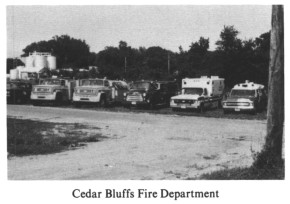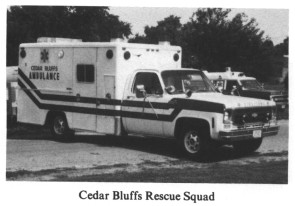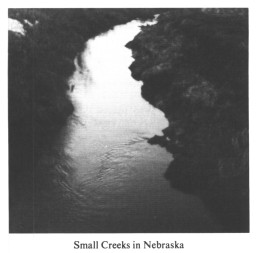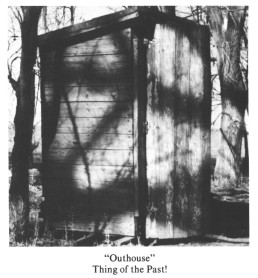|
In May of 1946, a new Ford truck with a 500-gal-per-minute water pump and a storage capacity of 300 gallons was purchased with contributions from the citizens of the village and surrounding community. In 1955, the Firemen's Hall was sold at a public auction for $750 and today is a family dwelling at 105 E. Oak. The rural district was formed in 1956. A new Dodge truck with a 500 gpm pump and a 500 gal. storage capacity was purchased. A new block building was constructed on the old Firemen's Hall site. In 1970, it was enlarged to house an ambulance and today it holds two tankers, a new pumper and ambulance; also a meeting room.
The Department had a system of fire phones located in 8 village homes. The fire whistle was activated by the person taking the call. In 1980, the Department converted to the Plectron radio system. Each fireman has a plectron in his home; the call is taken through the dispatcher in the sheriff's office, who activates the plectrons, alerting the firemen to the emergency and its location.
In 1976, the Village and Rural Fire Boards purchased a Chevrolet pumper. It holds 1000 gal. and pumps 750 gpm. The Rural Board purchased a Chev. Tanker in 1978. It has a portable pump, holds 1,600 gal and pumps 250 gpm. The 1956 Dodge tanker is still in use. Through the State Forestry Service, a 1964 Dodge 4x4 truck was obtained without cost. The firemen converted it into a specialized vehicle to fight grass and ditch fires with a 200-gal tank.
The Fire District covers a rural area of 60 sq. miles, which includes seven subdivisions: Villa Heights, Hillcrest, Riverview, Pawnee Meadows, Valley View Estates, The Spoonhour Div. and Woodcliff. Woodcliff alone consists of 360 dwellings.
 |
| Cedar Bluffs Fire Department |
The 1982 officers for the Cedar Bluffs Fire Dept. are: J. Penwell Fire Chief, A. Gienau Asst. Chief, Fire Capt. -- T. Townson, Sec-trea. -- Nick Svara, Rescue Squad Capt. -- Darwin Peterson, Asst Capt. -- Dorothe Peterson, and President -- G. Frey. In 1982 four women became firefighters to supplement the lack of men in the village during the day.
Fire Chief: 1900-1901 E. Peck, 1901-13 L. Schere 1913-19 A. Ostrand, 1919-26, 27-28 G. Boulier, 1926 R. Lochner, 1929, 31-33 O. Fenstermacher, 1930 J. Anderson, 1933 R. McIntyre, 1934-64 L. Knutzen, 1964-69 H. Knutzen, 1969-75 D. Miller, 1975-78 G. Frey, 1978-today Jim Penwell.
CEDAR BLUFFS RESCUE SQUAD
In 1970, a Fund Raising Drive was led by Henry Guinotte (pastor of the First Presbyterian Church) to purchase a Rescue Squad. The heartwarming response showed the public's realization of such need in Cedar Bluffs. In 1966, the businessmen of the village offered to buy a used ambulance if the firemen would operate it. The firemen agreed and responded so well that in 1970 there were ten men trained in first aid to operate the squad. The fund-raising drive netted $12,000. Using matching federal funds, a 1970 Chev. squad was purchased.
In 1982, the Firemen decided it was time for a newer squad and once again they turned to the people. With Capt. Darwin Peterson leading the drive for funds, $17,000 was raised. The Department purchased a used squad, a 1977 Chev. modular unit, keeping the 1970 squad as a backup unit that would respond to all fires with the fire trucks.
 |
| Cedar Bluffs Rescue Squad |
In 1982, the Department voted Dorothe Peterson as Asst. Captain for the Rescue Squad. She is the first woman to hold an office in the Cedar Bluffs Fire Dept. The Squad today is manned by both men and women with 14 EMT's, (Emergency Medical Technical with 80 hours of training) with 7 women and 7 men, the village and surrounding area is well-covered day and night in any emergency.
The Captains of the Rescue Squad: Rev. Henry Guinotte, Bob Weigand, Vernon Janovec, Dean Mahrt, Don Mahrt, Darwin Peterson -- present Captain.
CEDAR BLUFFS SENIOR
CITIZENS CENTER HISTORY
The Cedar Bluffs Senior Citizens Center opened March 27, 1979, under the name of the Cedar Bluffs Senior Diner, the first in this area. It is located in the Masonic Lodge at 124 North Main. The Center provides nutritious meals, socialization, and various services to the Senior Citizens of Cedar Bluffs and the surrounding area.
Reba Schaeffer, Director of the Lincoln Area Agency on Aging, and Donna Stoltenberg, first Center Manager, were active in organizing the Center. Senior Citizens in the community who served on the steering committee and made initial plans for the senior center were: Glenn and Arvella Hansen, Helen Gaughen, Norma Albertson, Ina Mae Wolfe, Frieda Suksdorf, Anita Barry and Alice Clinkenbeard.
The Senior Center provides nutritious meals every Tuesday, Wednesday and Friday. These meals are delivered from the central kitchen in Wahoo. Al Clinkenbeard is the present meal carrier with Glenn Hansen being the substitute. Home-delivered meals are delivered to shut-ins.
Other services provided are: outreach visits, information and referral, health clinics with free blood pressure clinic monthly, educational programs, and recreational program. Quilting is a favorite winter occupation with the ladies raising funds for the center from the profits of their work.
Special accomplishments while Donna Stoltenberg was manager were: expanding the facilities to include an Activity Room; organizing the Friendly Neighbors Club to support the Center; purchasing of a piano for the activity room; and organizing the first Pork Barbecue.
Pearl Crawford accepted the position of Center Manager in January, 1982. Helen Gaughen is the Green Thumb Worker. She is responsible for the phone calls and some record keeping. Lucille Scott is our Substitute Manager. All the Senior Center Members serve as volunteers and are VIP people at the center. The Senior Center couldn't operate without the efficient help of our all members.
Additions to the activity room this past year have included the Cedar Bluffs Satellite Library which Pat Janovec and her committee located in the Senior Center; a pool table which was donated to us by the Bethseda Home in Ashland; a quilting frame built and donated by Lloyd Konecky; and new lights purchased by the Friendly Neighbors and installed by Earl Vanderslice, Harold Roumph, Lloyd Konecky, Rick Konecky, Howard Thomsen and Art Jacobs.
The Cedar Bluffs Garden Club helped us sponsor a community Flower Show in June. Daisy Beck, Merle Wiegand, Ella Travnicek, and Alvina Lubker organized the Flower Show. There were 124 entries. August was the month for the annual Pork Barbecue. Earl Vanderslice and Art Jacobs donated the hog for the event. Earl did the barbecuing with able helpers.
Our newest project is the Senior Center Singers. Georgia Sudik is piano accompanist for the group. Earl Vanderslice and Lloyd Konecky are Song Leaders. Many guest appearances have been made. Join us at the Senior Center for fun and fellowship.
MASON LODGE #215
Occidental Lodge No.215 A.F. and A.M. was chartered on July 16, 1892. There were 20 members on the charter and the first meeting was held in a hall over the Charles McFarren Drug Store. Charles E. McFarren was elected the first Worshipful Master.
At the present time we have 40 members. The oldest active member is Walter Fleming of Cedar Bluffs. Walter was born on April 16, 1887 and was raised to the Master Mason Degree on May 24, 1910. He has been a member of Occidental Lodge for 73 years.
CEDAR BLUFFS GARDEN CLUB
In August 1959, Mrs. J. F. Spoonhour invited several women to see a flower arrangement demonstration by Mrs. Loyd Scott of Ashland. It was agreed that a garden club would be organized in September. The name "Cedar Bluffs Garden Club," was chosen and the motto "Do or Die" was adopted. The club flower is a rose.
The first members were Mmes. J. F. Spoonhour -- president, C. L. Lichtenberg, George Boullier, Walter Millet, Rudolf Sukstorf, August Wiegand and Adolph Travnicek. Shortly afterwards, Mmes. Ernest Ranslem, Herman Wiegand, Ernest Beck, E. H. Rhode and Arlene Rhode became members.
Club activities in past years have included annual tours to Shenandoah and Orange City, Iowa, Blair, Columbus, Clarkson, Lincoln, Omaha and Fremont. There have been lessons on gardening, flower arranging, conservation, garden therapy, and one year's sponsorship of a Junior Garden Club. Annual Christmas parties include husbands as guests, and in summer, a potluck luncheon features vegetables and fruits we have raised.
Many flower shows have been held. The 25th anniversary of the club's founding will be celebrated with a flower show in June, 1983.
Two members are serving as Rocky Mt. Region Representatives and on the Nebraska Federation's board. Three have served as District #2 Directors. At present, membership includes -- Daisy Beck, Mildred Papa, Rita Dirkschneider, Muriel Wiegand, Mmes. John Damman, Godfrey Schilke, Stanley Shavlik, James E. Wirka, John Sukstorf, Rudolph Sukstorf, Adolph Travnicek, Milton Carlburg, and Misses Alvena Lubker and Arlene Rhode.
THE COMMUNITY BALL FUND
PROGRAM IN CEDAR BLUFFS
In 1979, the Ball Fund Committee came into being. Its purpose was to provide funds for the summer ball program for the youth of the community and to find coaches. The program funded the Senior Girls Softball team's trips to Grand Island for the Class A State Tournament in 1980 and to North Platte for the Class B State Tournament in 1981.
In 1982, the Community Ball Fund Committee (one member from each organization in the community -- Firemen, Lions, Am. Leg., Am. Leg. Aux., Community Club, and Boy Scouts -- plus a girls' representative and boys' representative) met to formulate the rules by which the committee would be governed. They would head the Annual Barbecue which is held in the fall (proceeds fund the summer
page 54
ball program), and provide ball equipment. There is a baseball program for boys age 7 to 16 and a softball program (and T-ball) for girls age 7 to 18.
In 1983, over 100 children participated in the program.
LIONS CLUB
The organizational meeting for the Cedar Bluffs Lions Club was held on Jan.12, 1965, at the Cedar Bluffs Steak House. The meeting sponsored by the Fremont Lions Club. Although the club was organized on Jan.12, the official charter meeting was held on Jan.25, 1965.
On Jan.24, 1983, seven members of the club were honored as original charter members. They were 1st V.P.: Ray Grosse, Treas.: Paul Skovgaard, Tail Twister: Louis Lichtenberg, Jerald Holtorf, Melvin Holtorf, Howard Thomsen, and Frank Zima. Other current members are: Pres. -- Doug LeGrand; 2nd V.P. -- Rudolph Jessen; Sec. -- Rev. Stanley Tyner; Lion Tamer -- Allard Hartford; and Ron Dunn, Ron Konecky, Bill Primm, and Bob Wiegand.
Through the years the Cedar Bluffs Lions have tried to be sensitive to the needs of the people in our community and have made efforts to provide eye-glasses and hearing apparatus for those who have a genuine need, as well as participate in many community activities. Although the Lions have been concerned with sight, in recent years we have broadened our scope to include other health areas. As a result ofthis growing awareness, the club offers a $100 scholarship to a graduating girl or hoy who is going on to college in a health-related field.
EARLY SETTLER
SAMUEL BARRETT
Samuel Barrett, as a young man in Troy, Pennsylvania worked for a neighbor milking a big herd of 30 cows for 50¢ a day. He got tired of his father collecting his wages so decided to run away. In 1869, he took his father's horse, sold it and bought a railroad ticket as far west as the railroad went. This was Nebraska City.
From there he took off afoot and came upon the pioneer settlement south of the Platte River near Fremont. There were 11 families located there and he became acquainted with the family of Enoch Chritton whose daughter, Racheal Ellen, he later married. He decided to go farther west as he could homestead 160 acres there and only 80 acres here.
Again he walked until he came to Union Creek, 12 miles southwest of Madison, Nebraska and filed on 160 acres in Kalamazoo Township on Union Creek. This was the first homestead filed on this land.
Sam broke sod and dug wells for other settlers to earn a little cash. He made several trips on foot back to Saunders County to court Racheal Ellen. After a time they were married on June 29, 1873.
In 1874, the grasshoppers cleaned them out so he sold the land and moved to Saunders County in 1875. He bought 80 acres from Jimmy Kilborn for $10 an acre across from Chritton. He owed $800 and was to pay $200 down, but broke sod for Kilborn at $2.50 an acre.
The family lived in a dugout near a spring at first, where they got water for stock and household. It served them well but filled with mud in a big rain and had to be cleaned out.
Sam also worked for John Harris at the brickyard south of the present pipeline for $1 per day. He walked four miles to and from work and carried his dinner. They dug clay out of the bank, mixed it with sand and water, filled molds and baked the bricks.
Sam soon built a house near the spring and added rooms until he had four. Here the rest of their 12 children (nine grew to maturity) were born, without a doctor. A midwife, Granny Hilman, took care of mother and infant.
In winter, Sam bought a cow or steer and butchered it. He peddled the meat to neighbors, but always kept one quarter and the hide. He gave the heart and liver away. His family ate 13 quarters one winter. He figured his quarter and hide paid for the animal. When meat was scarce in summer, he butchered a hog. It was fried down, put in stone jars and covered with lard. There was a lot of work to raise a big family.
Sam broke sod and dug wells for other people. They finally got the land under cultivation and raised their own grain, garden, fruit and livestock. Lots of navy beans and potatoes were grown. In the fall, a deep trench was dug for storing potatoes. They put in a layer of straw, some dirt, potatoes, more straw and dirt and covered the pit with manure to keep it from freezing. It had a ventilator made of wood to let air in and prevent moisture as it was never opened until spring. They also stored potatoes, etc. in a cellar or cave. In the evening, Sam dumped 2½ bushels of navy beans on their homemade table and the children sorted them before bedtime. They used the split ones and sold the good ones for 80¢ per bushel. Sam and his sons cut ice in the river and packed it in straw in a deep ice house for summer use.
His wife baked bread every day besides making a two-gallon jar of pancake batter every morning. She also did all the sewing for the family as well as knitting socks, wrist bands, mittens, scarfs, etc. Sam would buy a bolt of calico (3¢ per yard) to make
dresses and a bolt of denim to make pants and jackets for the boys. They had a sewing machine to use and he built a cabinet to store it in. Woe to the child who meddled with that.
Wheat and corn were taken to a mill in Ashland to be ground. They raised cane that was stripped, cut and taken to a molasses mill two miles away to be processed into syrup. They also raised lots of berries and later had a big orchard.
They lived near the timber so had plenty of wood to burn, using a buck saw to cut it. Soap was made in a big iron kettle outside as well as lye from wood ashes.
 |
| Small Creeks in Nebraska |
Sam always had good discipline as he kept all the family busy. School let out during corn picking so he took about six of the younger ones, some no more than five years old, with him to the cornfield to shuck corn. When they got a load, the oldest son took it to the crib to unload, and they filled another wagon. It was thought he took them to the field to keep them from bothering their mother. Sam once unnailed the boards from a fence at the top of a hill and had two of the little boys carry them farther down to put up another fence. The boys were so small they could only carry one board between them, but they kept busy and out of mischief. Their dad sat and smoked until they got there so he could nail the boards on.
In harvest time, they shocked grain and did it just so. They put 10 bundles in a shock and spread two bundles in a shock and spread two bundles out to place on top of the shock. Their dad was very particular. He would jump on top of the shock to see if it would hold him up and they never knew which one he'd try.
They raked clover hay with wooden hand rakes to save the leaves. When they stacked wild hay, they swept it to the stack with two horses hitched to a rope in the center of a pole and also fastened to each end of the pole. One boy rode the pole and used a pitchfork to start the windrow. At the stack one end of the pole was raised and released the hay. They went after another load and the other boys stacked it, even at an early age. They also stacked wheat bundles, which later were threshed with a threshing machine. Corn was shelled with an old horsepowered sheller and sometimes with a hand sheller.
 |
"Outhouse"
Thing of the Past! |
After several years, in 1893, Sam built a seven-room house on the level land near a road to the river. He did all the work himself and was very particular. It all was back-plastered for extra warmth and had a good cellar. Sam dug, by hand, a 60-foot well and curbed it with lumber, near the house. It provided plenty of water for the house and livestock.
One year an epidemic of diphtheria struck the neighborhood and everyone was frightened. Sam, though he had a large family, went with a neighbor and buried the two who died. They let the coffins, made of rough lumber, down into the graves with lines from the harness and then offered a prayer. Two men who dug the graves, went to a far corner of the cemetery until they were through, and then they filled the graves.
The children carried bundles of sumac for kindling from the Staat's place and picked up cobs from the hog pen for fuel. One night Sam came home and they didn't have the cobs in. The children told him "Old Brigham" (the boar) had run them out of the pen. The older boys had teased him until he was mean. Sam thought he'd try it. In he went and out he came. He got a pitchfork but that didn't help. Next, he got a club and ran it down the hog's throat but still he came on. Finally, Sam got the shot gun and shot him.
page 55
| 
